Ataccama 15.2.0 Release Notes
Release Information
Products |
|
|---|---|
Release date |
|
Downloads |
|
Security updates |
Known Issues
| This section lists issues we are currently aware of which are considered significant, and which could impact the functionality of your build. We highly recommend reviewing this section before every upgrade. |
| Module | Issue | To be resolved in |
|---|---|---|
ONE |
ONE-54687: A change made to an instance of a child (embedded) entity does not trigger the parent entity to be included on the Unpublished tab of the entity listing screen even though it puts the parent entity in This occurs on all entity types that include an Unpublished tab (for example, terms, rules, and monitoring projects). |
TBD |
RDM |
ONE-61923: Generating the RDM model in ONE Desktop produces incorrect |
14.5.4, 15.3.0 |
MDM |
ONE-56889: After the history plugin refactoring, backward compatibility is broken and previously defined plugin settings are ignored. |
15.4.0 |
MDM |
ONE-54647: MDM fails to start when configured to use Amazon SQS. Contact Ataccama Support for further assistance. |
14.5.3, 15.3.0 |
Known Issues Resolved
We report known issues in each release. Below is the list of the issues that have been resolved across the platform for this version.
| Module | Issue | Reported in |
|---|---|---|
ONE |
ONE-53610: OAuth Google user credentials not working on BigQuery connection. |
14.5.1 |
ONE
Improvements to Rules
Version 15.2.0 brings a simplified and more intuitive way of creating DQ rules and applying them to attributes.
Quick Rule Creation Flow
You can now create a rule directly in Data Catalog and test it on sample data, which is particularly useful if you spot an issue while browsing the catalog.
The rules created this way use a simplified rule creation flow that contains only the most commonly used options for creating rules. The rule template is prefilled with input and test data from the catalog item, and the rule is automatically applied to the attribute it was created from.
You can always add advanced options, such as variables, later on in the rule library.
In addition to Data Catalog, this option is also available in Monitoring Projects and ONE Data.
For more information, see Create DQ Evaluation Rule.

Rule Suggestions
|
AI-based rule suggestions are available in Ataccama Cloud deployments only. |
When applying a rule, ONE can help you pick the rules that are most suited to evaluate your data.
You can use two types of rule suggestions: either select Check for rule suggestions to identify patterns and irregularities in the profiling statistics and suggest rules based on these, or use Detect rules for AI-generated rule suggestions.
If a suggested rule contains parameters or masks, the suggestion comes pre-populated with parameter and mask values derived from the profiling. Once you accept the rule suggestion, it is automatically applied to the attribute.
For more information, see Rule Suggestions.
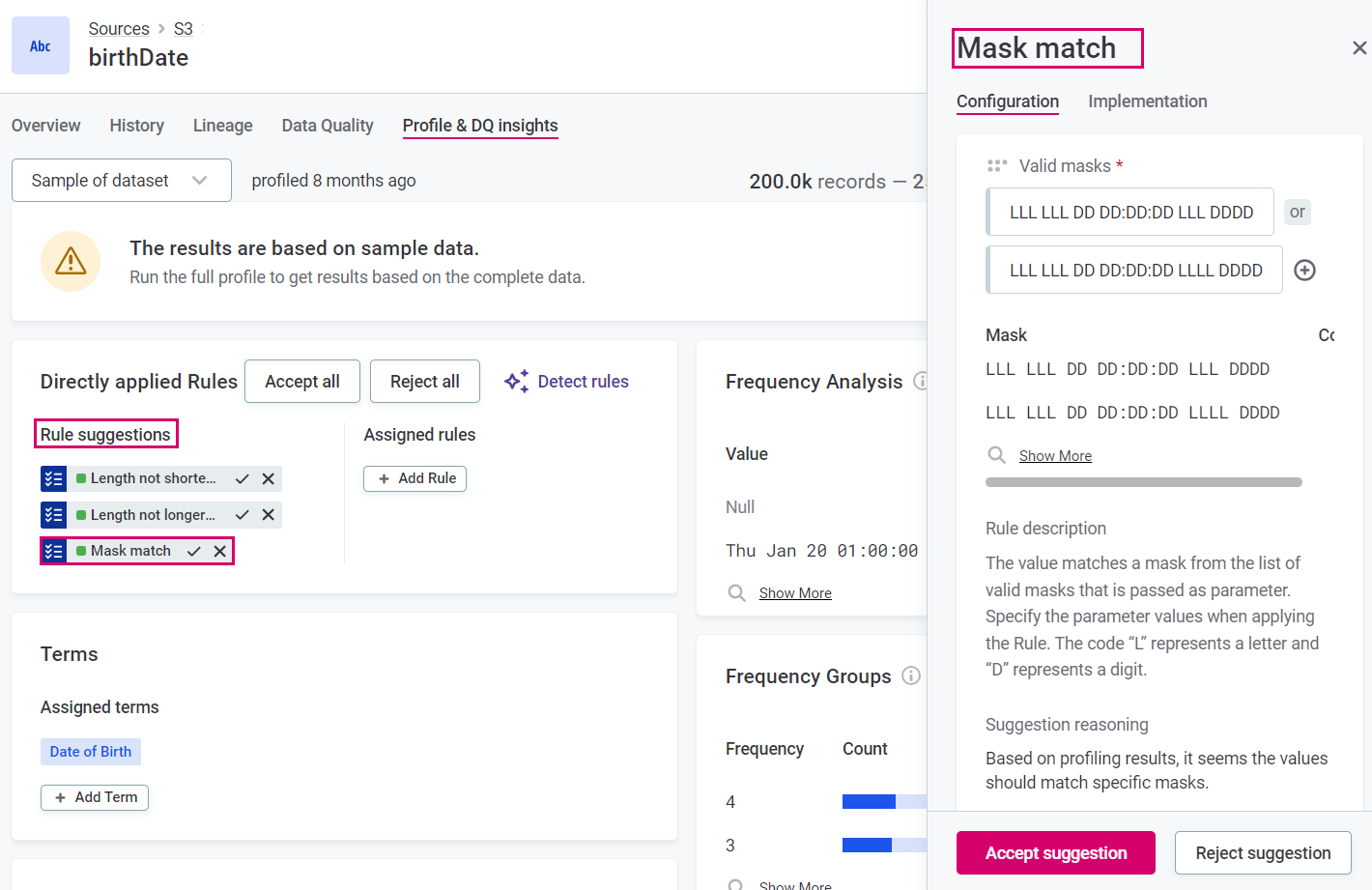
DQ Rules Can Use Parameters
Previously, if you needed data quality rules that differed just in small details (for example, two rules with “Has 1 digit” and “Has 2 digits” conditions, respectively), you had to create multiple rules. With parameters, you can now create reusable rules, where you replace the constant values in rule logic with parameters, and then provide parameter values when applying the rule to the attribute.
For more information, see Create DQ Evaluation Rule.

Secret Management Service
The new secret management service feature allows you to connect and provide access to your central storage locations and retrieve secrets from them when connecting to a data source. This allows for more secure storage and management of application secrets and keys and removes the need to manually provide sensitive information when setting up connections.
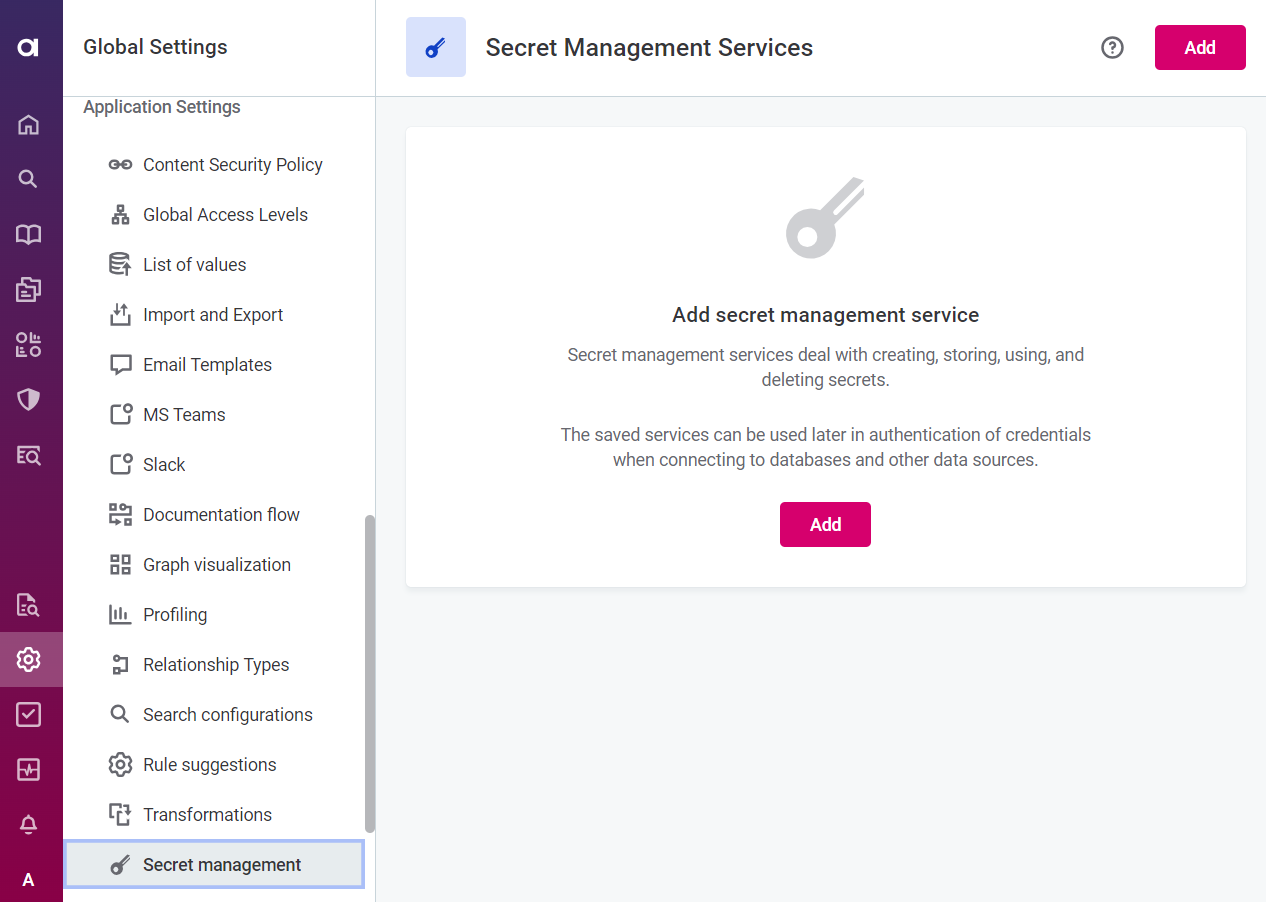
| Currently, the only supported provider is Azure Key Vault. |
| If you have previously configured Azure Key Vault credentials when connecting to a data source (either through driver properties in the case of relational databases or through the user interface in the case of Power BI and ADLS2 connections), see DQ&C 15.2.0 Upgrade Notes for information about how to align with the new secret management services. |
Redesigned UI for Azure Key Vault Connection Credentials
On all connections, it is now possible to configure the use of Azure Key Vault through the user interface.
The new interface also allows for the retrieval of Azure Key Vault values from the secret management service configured in ONE.
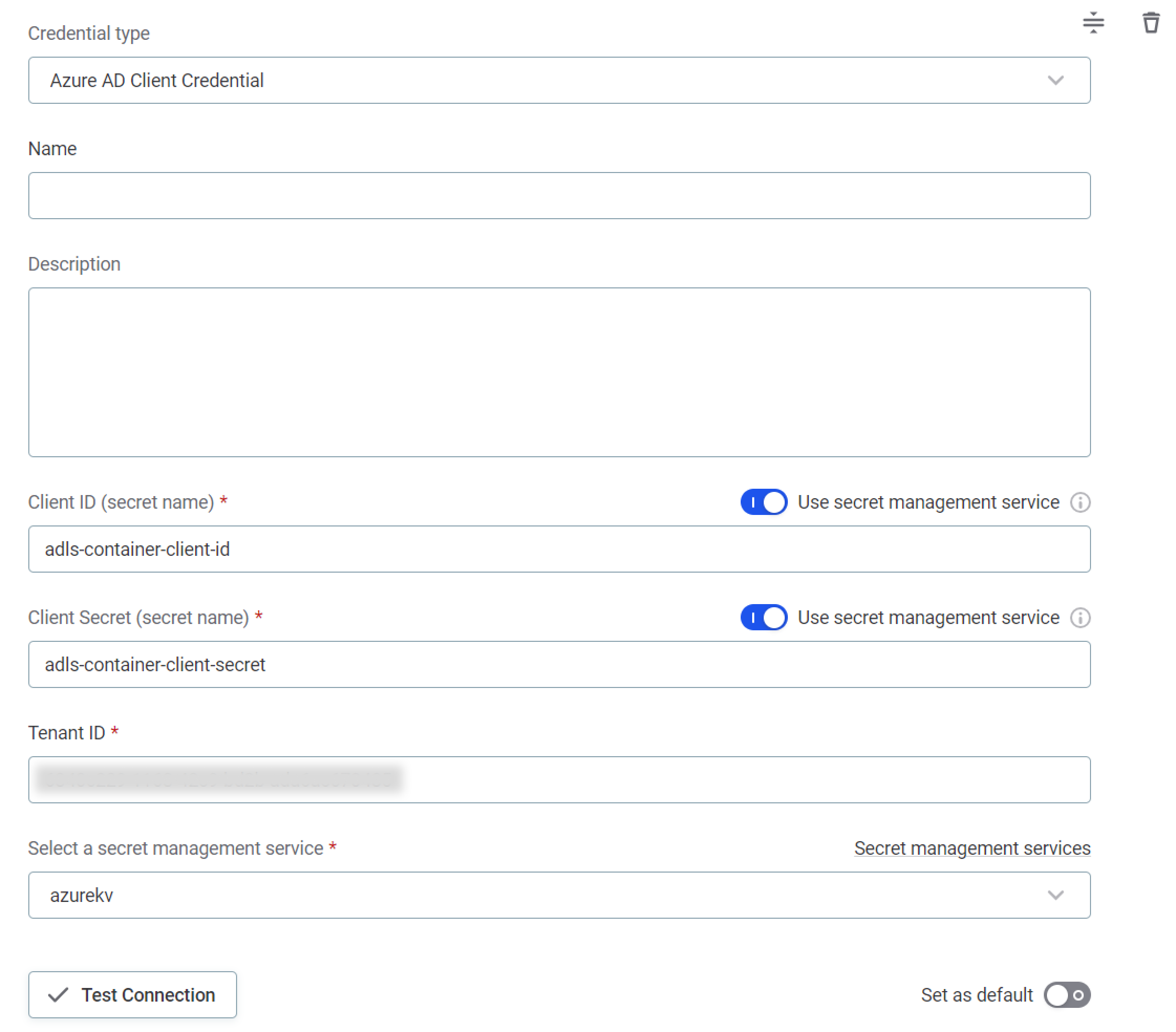
| When connecting to relational databases, it is no longer necessary to add driver properties in order to use Azure Key Vault. |
| If you have previously configured Azure Key Vault credentials when connecting to a data source (either through driver properties in the case of relational databases or through the user interface in Power BI and ADLS2 connections), see DQ&C 15.2.0 Upgrade Notes for information about how to align with the new secret management services. |
Manage Access to Assets in Bulk
For more efficient user access management, you can now perform these actions in bulk:
-
Share access to assets.
-
Assign stewardship to assets.
For more information, see Share Access and Assign Stewardship in Bulk.
Support for OneLake
A dedicated connection interface has been added for OneLake: select OneLake when adding a new connection. OneLake is provided automatically with every Microsoft Fabric tenant and is designed to be the single location for your organization’s analytics data.
See OneLake.
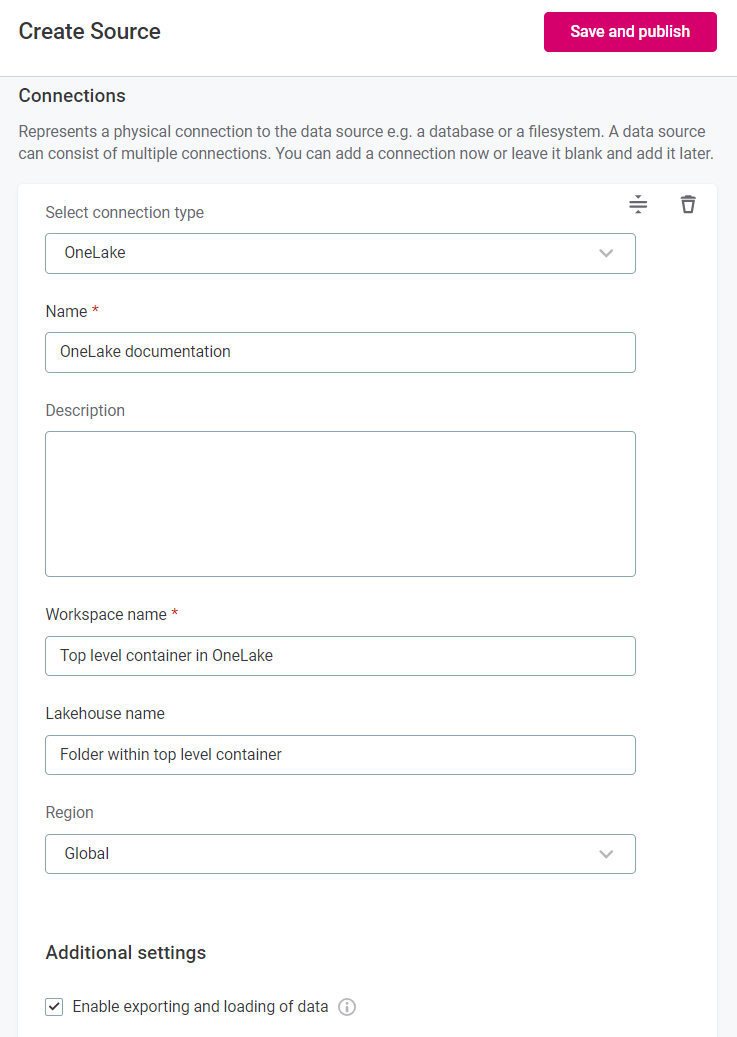
Support for Lakehouse SQL Analytics Endpoint
When you create a Lakehouse in Microsoft Fabric, it automatically generates an SQL analytics endpoint. Using this endpoint, you can work with delta lake files in the Lakehouse as if they were stored in an SQL database.
Lakehouse SQL analytics endpoint has been added to the list of possible connections when you are adding a new connection.
For more information about how to construct the correct JDBC string, see Lakehouse SQL Analytics Endpoint.
ONE Data
Deactivate or Limit ONE Data
The ONE Data module can now be turned off or limited in functionality using specific feature flags. There are three options:
-
ONE Data: Deactivate ONE Data entirely.
-
ONE Data Load: Turn off the option to load data from catalog items to ONE Data for data management and remediation.
-
ONE Data Load limited to reference data: Limit the option to load data to allow loading only reference data into the module.
How these settings are managed depends on your deployment type:
-
Self-managed deployments: The feature flags are included in the provided Ansible scripts.
-
Ataccama Cloud: These settings can be managed in the configuration interface (Cloud Portal), from the Settings tab > Experimental features section of a specific environment.

|
By default, ONE Data is distributed as follows for all deployment types:
|
Data Stories
Enhanced Filter and Chart Settings
Filter and chart settings now have a more streamlined look and are optimized for usability on smaller screens. This includes reduced padding between components and smaller component versions, resulting in a tidier interface overall.
Visualization Builder Improvements
The Visualization Builder is now better adjusted for smaller screen resolutions, featuring a reduced default width for the attribute bar, an updated closing icon, and reduced padding (both vertical and horizontal). Likewise, switching between data table and visualization is more intuitive (using icons instead of text), and there is a shadow effect in the visualization area for better visual separation.
In addtion, you can now customize the formatting of numeric values in your visualizations. You can adjust decimal places, select separators for decimal places and thousands, add prefixes or suffixes, and abbreviate large numbers to better suit your preferences.
General UI Improvements
-
Updated empty state for no filter results: Improved messaging for cases when no data is displayed due to filters applied,
-
Revamped Select/Create collection modal: When creating a new visualization, it’s now easier to select between existing collections or create a new one directly from the modal.
-
Create buttons on Home and Report screens: When you select Create on the Home or Report screen, you can no longer create individual visualizations, only dashboards or stories.
-
Editable slide names: Rename slides with a simple double-click, the same way you edit story or dashboard titles.
-
Renamed Add transition to side option: The Add transition to side option is renamed to Slide-in horizontally to better reflect its functionality. This option allows slides to move horizontally in Presentation or View mode, offering an alternative to the default vertical transition.
RDM
Improved Authentication
RDM Web App now utilizes Keycloak Session Idle Timeout and Session Max configuration effectively.
You are now automatically logged out and notified via a popup dialog when the idle timeout or maximum session duration is reached.
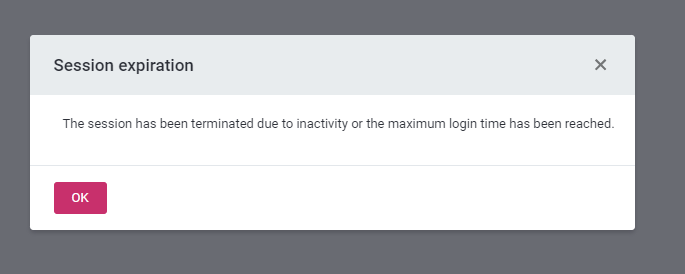
Row Validation Strategy
We introduced the option to turn off the automatic record validation when editing data.
If the new validation mode is used on a table, you need to manually validate data in the web application before you can save or publish your changes. As such, it is best applied on tables with complex and time-consuming validation logic defined.
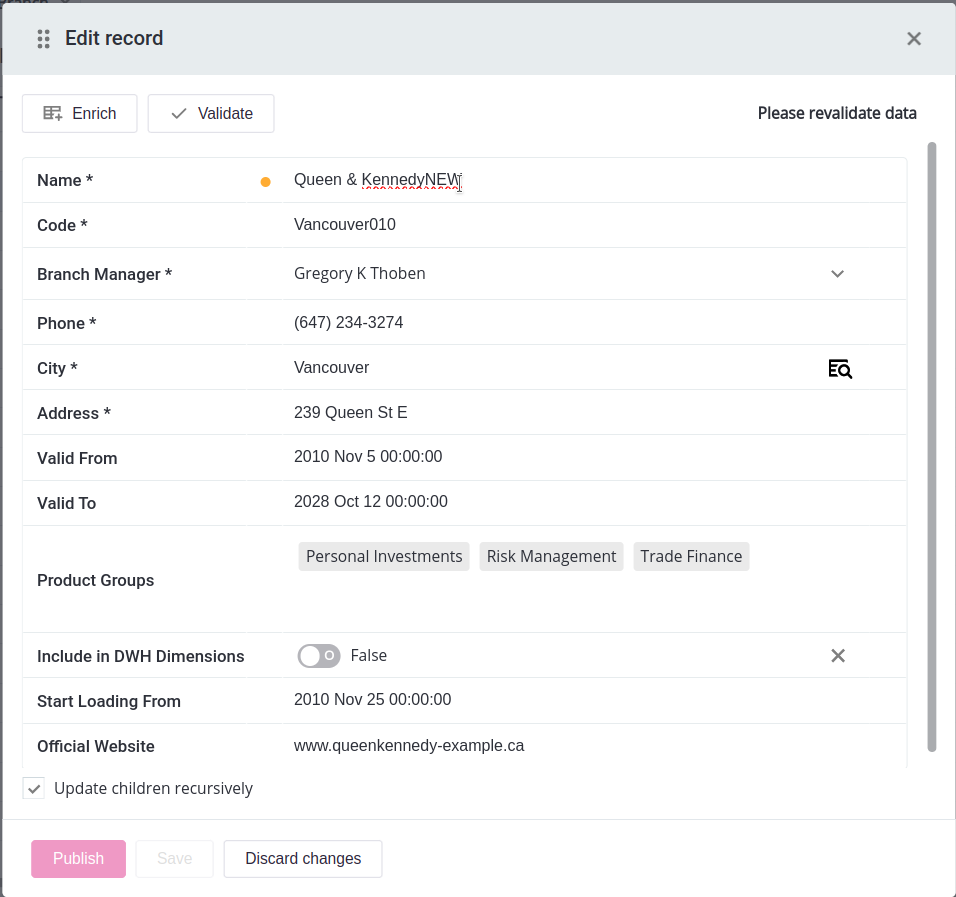
To configure this, change the Row validation strategy for the table in question to MANUAL (by default, the ON_THE_FLY strategy is used).
For details, see Tables, section Table attributes > General.
Fixes
ONE
Click here to expand (15.2.0-patch4)
Click here to expand (15.2.0-patch3)
Click here to expand (15.2.0-patch2)
-
ONE-59181: Fixed upgradeability in cloud deployments.
Click here to expand (15.2.0-patch1)
Click here to expand
-
ONE-52844: Navigating to the second page of the step listing in transformation plans now shows a list of steps instead of an error.
-
ONE-50188: Specific notifications in monitoring projects now support fractions in thresholds.
-
ONE-53773: Fixed issue where it was not possible to set notification threshold as 100% in monitoring project notifications.
-
ONE-54444: Schema changes in Data Observability are now detected even when all schemas are selected.
-
ONE-53891: Fixed issue where freshness was not working because of missing freshness properties in Data Processing Engine (DPE)
etc/application.properties. -
ONE-54093: The Description field in DQ firewalls is now of the Rich Text Field data type.
-
ONE-54134: In Data Observability, the anomaly detection model in profiling now correctly reflects changes in global profiling configuration.
-
ONE-54160: Fixed issue where DQ evaluation did not start for certain file types or sources when running Full Profile & DQ Evaluation.
-
ONE-53921: Post-processing plans are now correctly imported in monitoring project imports.
-
ONE-53070: Corrected the missing
osvalue in theuriproperty in MS Teams notification templates. -
ONE-53623: The notification migration script no longer causes duplicate entries in
personReferencein MMM database. -
ONE-51377: Anomaly description in the Record Volume tab on the Data Observability dashboard is correctly displayed.
-
ONE-51507: Improved the copy for catalog item invalid samples.
-
ONE-51162: Monitoring project validation no longer fails after a user tries to delete a catalog item attribute referenced by a monitoring project filter.
-
ONE-51385: Fixed an issue where Slack notifications were not sent when an issue was detected in a monitoring project.
-
ONE-50829: Fixed issues where changing freshness Detection type in the configuration updated catalog item Status and Threshold to incorrect values.
-
ONE-53450: Fixed issue with DQ rule preview in Data Catalog, where variables were displayed with variable validation error.
-
ONE-53152: Users with the View metadata access can run monitoring projects as expected.
-
ONE-51359: Fixed issue with unwanted notifications and invisible legacy recipients in monitoring projects notifications.
-
ONE-53553: Removed the DQ Firewall option from the term Occurrence tab in Business Glossary.
-
ONE-53518: Fixed performance issue with slow loading of catalog items with rich anomaly history.
-
ONE-53507: Fixed the issue with DQ firewall Test Rule option not working for component rules with lookup in MinIO.
-
ONE-53633: Reconciliation projects can now run metadata import only on selected assets (sources, locations, catalog items).
-
ONE-52805: In monitoring projects, users can no longer add deleted DQ rule suggestions to custom aggregation.
-
ONE-52324: When configuring Data Observability Freshness groups, you can now search for catalog items using dynamic fields.
-
ONE-50706: Validation messages in transformation plans use correct field names.
-
ONE-51464: Data Steward can now preview issues on the list of sources in Data Observability.
-
ONE-55683, ONE-56082: Fixed the issue where monitoring projects stayed in a draft state when they were not supposed to.
MDM
Click here to expand
-
ONE-51988: AI matching initialization no longer freezes during the initial run in on-demand deployments.
-
ONE-52412: Previewing data in ONE for MDM Datasource now works as expected.
-
ONE-52237: MDM server starts as expected in cloud deployments.
-
ONE-51208: MDM Web App elements misplacement and overflow was fixed.
-
ONE-53497, ONE-52687, ONE-52690: High Availability configuration was improved.
-
ONE-51922: MDM permissions issue was fixed.
-
ONE-51799: MDM task description is now displayed as expected.
-
ONE-52236: Automatic tasks can be created as expected on instance entities.
-
ONE-52890: Merge & Split Instances in compare view feature reimplemented.
-
ONE-53683: Virtual instance records detail is now displayed as expected in the MDM Web App.
-
ONE-54032: MDM server starts as expected when using workflows.
-
ONE-53458: Editing virtual instance records in the MDM Web App now works as expected.
-
ONE-56206: MDM matching now works as expected.
-
ONE-56109: The MDM server no longer fails during transactions due to duplicate record conflicts.
-
ONE-51716: The issue preventing MDM Web App from starting has been resolved.
-
ONE-53245: Duplicate records no longer appear in MDM due to server restarts during the data loading process.
-
ONE-54349: The issue of record duplication in MDM on the Oracle database was fixed.
RDM
Click here to expand
-
ONE-54183: Entity column permissions keep the correct values after synchronizing the permissions cache.
-
ONE-53206: The Enrichment feature works as expected in self-managed deployments.
-
ONE-52502: An error no longer appears when applying a new configuration in RDM Admin Console in self-managed deployments.
-
ONE-51518: RDM Importer step now functions as expected.
-
ONE-50312: Users with view-only permissions on a table no longer have access to the Restore action.
-
ONE-54232: In Ataccama Cloud, the Add configuration option works as expected after making changes to the Git repository configuration.
Was this page useful?
